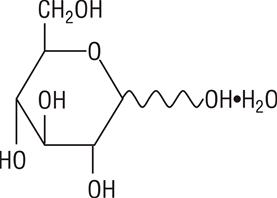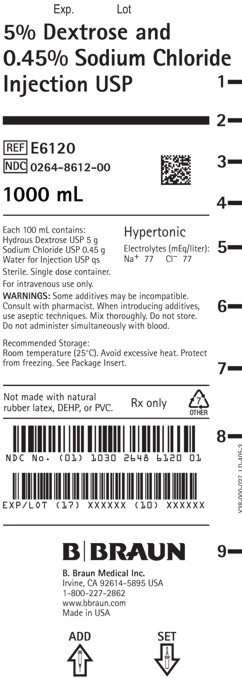DEXTROSE AND SODIUM CHLORIDE- dextrose and sodium chloride injection, solution
B. Braun Medical Inc.
----------
Dextrose and Sodium Chloride Injection USP
DESCRIPTION
Each 100 mL of 5% Dextrose and 0.45% Sodium Chloride Injection USP contains: Hydrous Dextrose USP 5 g; Sodium Chloride USP 0.45 g; Water for Injection USP qs
pH: 4.4 (3.5-6.5)
Calculated Osmolarity: 406 mOsmol/liter, hypertonic
Concentration of Electrolytes (mEq/liter): Sodium 77 Chloride 77
5% Dextrose and 0.45% Sodium Chloride Injection USP is sterile, nonpyrogenic and contains no bacteriostatic or antimicrobial agents. This product is intended for intravenous administration.
The formulas of the active ingredients are:
| Ingredients | Molecular Formula | Molecular Weight |
| Sodium Chloride USP | NaCI | 58.44 |
| Hydrous Dextrose USP |  | 198.17 |
Not made with natural rubber latex, DEHP, or PVC.
The plastic container is made from a homogenous blend of polypropylene and thermoplastic modifier specifically developed for parenteral drugs. The container is nontoxic and biologically inert. The container is a closed system and is not dependent upon entry of external air during administration.
Addition of medication should be accomplished using complete aseptic technique.
The closure system has two ports; the one for the administration set and the other is a medication addition site. Each port has a tamper evident cover. Refer to the Directions for Use of the container.
CLINICAL PHARMACOLOGY
5% Dextrose and 0.45% Sodium Chloride Injection USP provides electrolytes and calories and is a source of water for hydration. It is capable of inducing diuresis depending on the clinical condition of the patient.
Sodium, the major cation of the extracellular fluid, functions primarily in the control of water distribution, fluid balance, and osmotic pressure of body fluids. Sodium is also associated with chloride and bicarbonate in the regulation of the acid-base equilibrium of body fluid.
Chloride, the major extracellular anion, closely follows the metabolism of sodium, and changes in the acid-base balance of the body are reflected by changes in the chloride concentration.
Dextrose provides a source of calories. Dextrose is readily metabolized, may decrease losses of body protein and nitrogen, promotes glycogen deposition and decreases or prevents ketosis if sufficient doses are provided.
INDICATIONS AND USAGE
This intravenous solution is indicated for use in adults and pediatric patients as a source of electrolytes, calories and water for hydration.
CONTRAINDICATIONS
This solution is contraindicated where the administration of sodium or chloride could be clinically detrimental.
Solutions containing dextrose may be contraindicated in patients with hypersensitivity to corn products.
WARNINGS
The administration of intravenous solutions can cause fluid and/or solute overload resulting in dilution of serum electrolyte concentrations, overhydration, congested states or pulmonary edema. The risk of dilutional states is inversely proportional to the electrolyte concentration. The risk of solute overload causing congested states with peripheral and pulmonary edema is directly proportional to the electrolyte concentration.
Solutions containing sodium ions should be used with great care, if at all, in patients with congestive heart failure, severe renal insufficiency, and in clinical states in which there is sodium retention with edema. In patients with diminished renal function, administration of solutions containing sodium ions may result in sodium retention.
Excessive administration of potassium-free dextrose solutions may result in significant hypokalemia. Serum potassium levels should be maintained and potassium supplemented as required.
Solutions containing dextrose and low electrolyte concentrations should not be administered simultaneously with blood through the same infusion set because of the possibility of pseudoagglutination or hemolysis.
PRECAUTIONS
General
This solution should be used with care in patients with hypervolemia, renal insufficiency, urinary tract obstruction, or impending or frank cardiac decompensation.
Extraordinary electrolyte losses such as may occur during protracted nasogastric suction, vomiting, diarrhea or gastrointestinal fistula drainage may necessitate additional electrolyte supplementation.
Additional essential electrolytes, minerals and vitamins should be supplied as needed.
Sodium-containing solutions should be administered with caution to patients receiving corticosteroids or corticotropin, or to other salt-retaining patients. Care should be exercised in administering solutions containing sodium to patients with renal or cardiovascular insufficiency, with or without congestive heart failure, particularly if they are postoperative or elderly.
Solutions containing dextrose should be used with caution in patients with overt or known subclinical diabetes mellitus, or carbohydrate intolerance for any reason.
Hypokalemia may develop during parenteral administration of hypertonic dextrose solutions. Sufficient amounts of potassium should be added to dextrose solutions administered to fasting patients with good renal function, especially those on digitalis therapy.
To minimize the risk of possible incompatibilities arising from mixing this solution with other additives that may be prescribed, the final infusate should be inspected for cloudiness or precipitation immediately after mixing, prior to administration and periodically during administration.
Do not use plastic container in series connection.
If administration is controlled by a pumping device, care must be taken to discontinue pumping action before the container runs dry or air embolism may result.
This solution is intended for intravenous administration using sterile equipment. It is recommended that intravenous administration apparatus be replaced at least once every 24 hours.
Use only if solution is clear and container and seals are intact.
Laboratory Tests
Clinical evaluation and periodic laboratory determinations are necessary to monitor changes in fluid balance, electrolyte concentrations, and acid-base balance during prolonged parenteral therapy or whenever the condition of the patient warrants such evaluation. Significant deviations from normal concentrations may require tailoring of the electrolyte pattern, in these or alternative solutions.
Carcinogenesis, Mutagenesis, Impairment of Fertility
Studies with 5% Dextrose and 0.45% Sodium Chloride Injection USP have not been performed to evaluate carcinogenic potential, mutagenic potential, or effects on fertility.
Pregnancy
Teratogenic Effects
Pregnancy Category C. Animal reproduction studies have not been conducted with 5% Dextrose and 0.45% Sodium Chloride Injection USP. It is also not known whether 5% Dextrose and 0.45% Sodium Chloride Injection USP can cause fetal harm when administered to a pregnant woman or can affect reproduction capacity. 5% Dextrose and 0.45% Sodium Chloride Injection USP should be given to a pregnant woman only if clearly needed.
Labor and Delivery
The effects of 5% Dextrose and 0.45% Sodium Chloride Injection USP on the duration of labor or delivery, on the possibility that forceps delivery or other intervention or resuscitation of the newborn will be necessary, and on the later growth, development, and functional maturation of the child are unknown.
As reported in the literature, sodium and dextrose containing solutions have been administered during labor and delivery. Caution should be exercised, and the fluid balance, glucose and electrolyte concentrations, and acid-base balance, of both mother and fetus should be evaluated periodically or whenever warranted by the condition of the patient or fetus.
Nursing Mothers
It is not known whether this drug is excreted in human milk. Because many drugs are excreted in human milk, caution should be exercised when 5% Dextrose and 0.45% Sodium Chloride Injection USP is administered to a nursing woman.
Pediatric Use
Safety and effectiveness of 5% Dextrose and 0.45% Sodium Chloride Injection USP in pediatric patients have not been established by adequate and well-controlled studies.
Dextrose is safe and effective for the stated indications in pediatric patients (see INDICATIONS AND USAGE). As reported in the literature, the dosage selection and constant infusion rate of intravenous dextrose must be selected with caution in pediatric patients, particularly neonates and low birth weight infants, because of the increased risk of hyperglycemia/hypoglycemia. Frequent monitoring of serum glucose concentrations is required when dextrose is prescribed to pediatric patients, particularly neonates and low birth weight infants.
In neonates or in very small infants even small volumes of fluid may affect fluid and electrolyte balance. Care must be exercised in treatment of neonates, especially pre-term neonates, whose renal function may be immature and whose ability to excrete fluid and solute loads may be limited. Fluid intake, urine output, and serum electrolytes should be monitored closely. See WARNINGS and DOSAGE AND ADMINISTRATION.
Geriatric Use
Clinical studies of 5% Dextrose and 0.45% Sodium Chloride Injection USP did not include sufficient numbers of subjects aged 65 and over to determine whether they respond differently from younger subjects. Other reported clinical experience has not identified differences in responses between elderly and younger patients.
In general, dose selection for an elderly patient should be cautious, usually starting at the low end of the dosing range, reflecting the greater frequency of decreased hepatic, renal, or cardiac function, and of concomitant disease or other drug therapy.
This drug is known to be substantially excreted by the kidney, and the risk of toxic reactions to this drug may be greater in patients with impaired renal function. Because elderly patients are more likely to have decreased renal function, care should be taken in dose selection, and it may be useful to monitor renal function.
See WARNINGS.
ADVERSE REACTIONS
Reactions which may occur because of the solution or the technique of administration include febrile response, infection at the site of injection, venous thrombosis or phlebitis extending from the site of injection, extravasation and hypervolemia.
Too rapid infusion of hypertonic solutions may cause local pain and venous irritation. Rate of administration should be adjusted according to tolerance. Use of the largest peripheral vein and a small bore needle is recommended. (See DOSAGE AND ADMINISTRATION.)
Symptoms may result from an excess or deficit of one or more of the ions present in the solution; therefore, frequent monitoring of electrolyte levels is essential.
Hypernatremia may be associated with edema and exacerbation of congestive heart failure due to the retention of water, resulting in an expanded extracellular fluid volume.
If infused in large amounts, chloride ions may cause a loss of bicarbonate ions, resulting in an acidifying effect.
The physician should also be alert to the possibility of adverse reactions to drug additives diluted and administered from the plastic container. Prescribing information for drug additives to be administered in this manner should be consulted.
If an adverse reaction does occur, discontinue the infusion, evaluate the patient, institute appropriate therapeutic countermeasures, and save the remainder of the fluid for examination if deemed necessary.
OVERDOSAGE
In the event of a fluid or solute overload during parenteral therapy, reevaluate the patient’s condition and institute appropriate corrective treatment.
DOSAGE AND ADMINISTRATION
This solution is for intravenous use only.
Dosage is to be directed by a physician and is dependent upon age, weight, clinical condition of the patient and laboratory determinations. Frequent laboratory determinations and clinical evaluation are essential to monitor changes in blood glucose and electrolyte concentrations, and fluid and electrolyte balance during prolonged parenteral therapy.
When a hypertonic solution is to be administered peripherally, it should be slowly infused through a small bore needle, placed well within the lumen of a large vein to minimize venous irritation. Carefully avoid infiltration.
Fluid administration should be based on calculated maintenance or replacement fluid requirements for each patient.
Some additives may be incompatible. Consult with pharmacist. When introducing additives, use aseptic techniques. Mix thoroughly. Do not store.
Parenteral drug products should be inspected visually for particulate matter and discoloration prior to administration, whenever solution and container permit.
Pediatric Use
There is no specific pediatric dose. The dose is dependent on weight, clinical condition, and laboratory results. See WARNINGS and PRECAUTIONS.
HOW SUPPLIED
5% Dextrose and 0.45% Sodium Chloride Injection USP is supplied sterile and nonpyrogenic in Plastic Containers. The 1000 mL containers are packaged 12 per case.
| NDC | REF | Size |
| 0264-8612-00 | E6120 | 1000 mL |
Exposure of pharmaceutical products to heat should be minimized. Avoid excessive heat. Protect from freezing. It is recommended that the product be stored at room temperature (25°C); however, brief exposure up to 40°C does not adversely affect the product.
Directions for Use of Plastic Container
Caution: Do not use plastic container in series connection.
To Open
Check for minute leaks by squeezing solution container firmly. If leaks are found, discard solution as sterility may be impaired. If supplemental medication is desired, follow directions below before preparing for administration.
NOTE: Before use, perform the following checks:
- Inspect each container. Read the label. Ensure solution is the one ordered and is within the expiration date.
- Invert container and carefully inspect the solution in good light for cloudiness, haze, or particulate matter. Any container which is suspect should not be used.
- Use only if solution is clear and container and seals are intact.
Preparation for Administration
- Remove plastic protector from sterile set port at bottom of container.
- Attach administration set. Refer to complete directions accompanying set.
To Add Medication
Warning: Some additives may be incompatible.
To Add Medication Before Solution Administration
- Prepare medication site. Remove additive port closure and swab exposed medication site.
- Using syringe with 18-22 Ga. needle, puncture medication port and inner diaphragm and inject.
- Squeeze and tap ports while ports are upright and mix solution and medication thoroughly.
To Add Medication During Solution Administration
- Close clamp on the set.
- Prepare medication site. Remove additive port closure and swab exposed medication site.
- Using syringe with 18-22 Ga. needle of appropriate length (at least 5/8 inch), puncture resealable medication port and inner diaphragm and inject.
- Remove container from IV pole and/or turn to an upright position.
- Evacuate both ports by tapping and squeezing them while container is in the upright position.
- Mix solution and medication thoroughly.
- Return container to in use position and continue administration.
B. Braun Medical Inc.
Irvine, CA 92614-5895 USA
1-800-227-2862
www.bbraun.com
Made in USA
Rx only
Package Insert
Y36-002-836 LD-437-1
Initiated: May 2013
PRINCIPAL DISPLAY PANEL
5% Dextrose and 0.45% Sodium Chloride Injection USP
REF E6120
NDC 0264-8612-00
1000 mL
Each 100 mL contains:
Hydrous Dextrose USP 5 g
Sodium Chloride USP 0.45 g
Water for Injection USP qs
Hypertonic
Electrolytes (mEq/liter): Na+ 77 Cl– 77
Sterile. Single dose container.
For intravenous use only.
WARNINGS: Some additives may be incompatible. Consult with pharmacist. When introducing additives, use aseptic techniques. Mix thoroughly. Do not store. Do not administer simultaneously with blood.
Recommended Storage:
Room temperature (25°C). Avoid excessive heat. Protect from freezing. See Package Insert.
Not made with natural rubber latex, DEHP, or PVC.
Rx only

B. Braun Medical Inc.
Irvine, CA 92614-5895 USA
1-800-227-2862
www.bbraun.com
Made in USA
Y38-000-027 LD-405-3
Exp. Lot
ADD SET

| DEXTROSE AND SODIUM CHLORIDE
dextrose and sodium chloride injection, solution |
||||||||||||||||||||
|
||||||||||||||||||||
|
||||||||||||||||||||
|
||||||||||||||||||||
|
||||||||||||||||||||
|
||||||||||||||||||||
| Labeler - B. Braun Medical Inc. (002397347) |
| Establishment | |||
| Name | Address | ID/FEI | Business Operations |
|---|---|---|---|
| B. Braun Medical Inc. | 037425308 | LABEL(0264-8612) , MANUFACTURE(0264-8612) , PACK(0264-8612) | |